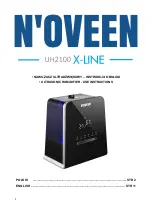
quest
Asset Protection and IAQ Solutions
quest
1-800-533-7533
Quest
DRY
150 Installation, Operation and Maintenance Instructions
www.thermastor.com
3.4E Installation in a Ceiling Cavity with an Existing Forced Air HVAC System
ALWAYS install a catch pan with a drain and/or float interrupt switch for condensate under the Quest
DRY
150 in an attic to reduce likelihood of water damage.
Locate a separate return for the Quest
DRY
150 in a central area of the structure. Duct the supply of the
Quest
DRY
150 to the air supply of the existing HVAC system. Connect an insulated duct from outside to
the 6" collar of the Quest
DRY
150 if you wish to
provide fresh air ventilation. Adjust damper in the
collar to provide the desired amount of fresh air.
Using a remote control, program the unit to bring
in the desired amount of fresh air.
3.4F Installation in a Structure with Two Forced
Air HVAC Systems
The Quest
DRY
150 can be installed into two
typical HVAC ducting systems. Install a separate
return for the Quest
DRY
150 as directed above.
Discharge air from the dehumidifier should be
split and routed to each supply ducting system.
A balancing damper and a back draft damper
is required in each duct between the Quest
DRY
150 and the HVAC ducting system. This
allows airflow to be adjusted and prevents flow of air between the ducting systems. Contact the factory for
assistance, if necessary.
3.4G Installation in a Structure with No Existing Forced Air HVAC System
When installing the Quest
DRY
150 in a structure that does not have a forced air HVAC system, a single
return for the Quest
DRY
150 should be installed in central open area of the structure. DO NOT locate the
return in a rest room or a kitchen or cooking area. The supply of the Quest
DRY
150 should be located in the
remote areas of the structure (such as bedrooms, den, etc.). By ducting this way, the air inside the structure
will circulate through the Quest
DRY
150 to be filtered and dehumidified. Avoid discharging all the air from
the dehumidifier in one location to prevent heat build up in that area. 4" diameter duct is recommended for
branches to the smaller areas, 6" diameter duct is recommended for branches to larger areas. Refer to section
3.4B for branch duct sizing. Connect an insulated duct from outside to the 6" collar of the Quest
DRY
150 if
you wish to provide fresh air ventilation.
3.5 Quiet Installation
Consider compression vibration and airflow noise during installation. Use of flex duct and/or vibration
isolation materials during mounting and ducting will result in quieter operation.
3.6 Noise Abatement
A length of flexible ducting on all Quest
DRY
150 duct connections is recommended to reduce noise and
vibration transmitted to rigid duct work in the structure.
FOR HVAC INSTALLER ONLY









































